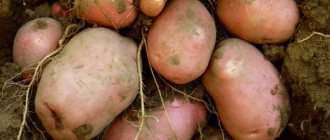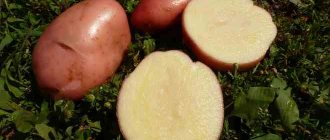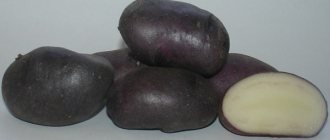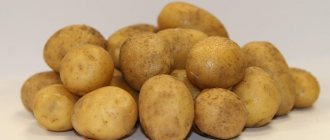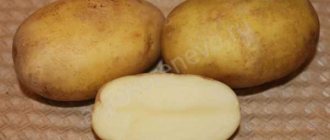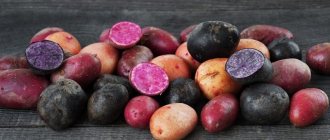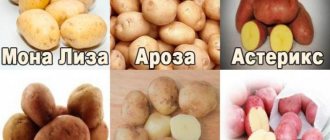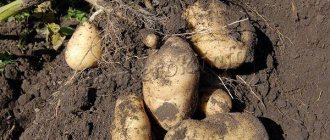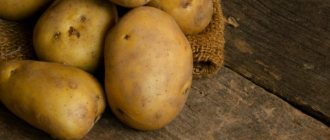Potatoes are a popular crop that many people grow in their summer cottages. When choosing planting material, you must be guided by varietal characteristics. Among the mid-early varieties, Deva potatoes are distinguished. It is high-yielding, has good taste and can grow in any region of Russia. Before purchasing planting material, you need to familiarize yourself with the strengths and weaknesses of the variety, view photos and study the description of the Virgo potato.
Pros and cons of the Virgo variety
Virgo potatoes, like any variety, have positive and negative qualities. The positive characteristics of Virgo potatoes include:
- high fruiting;
- resistance to diseases and temperature changes;
- unpretentiousness in care and soil quality;
- good taste and presentation;
- universal application.
The variety has no disadvantages.
Potatoes “Juvel”: variety description, photo
| Variety name | Jewel |
| Maturation period | 50-65 days |
| Starch content | 10-15% |
| Weight of marketable tubers | 80-150 gr |
| Number of tubers in a bush | up to 20 |
| Productivity | 700 c/ha |
| Consumer qualities | normal taste, average cooking ability, suitable for frying |
| Keeping quality | 94% |
| Peel color | yellow |
| Flesh color | yellow |
| Preferred Growing Regions | any soil and climate |
| Disease resistance | resistant to golden potato nematode, cancer, PVYn virus and late blight of tubers, moderately resistant to late blight of tops. |
| Features of cultivation | Drought-resistant, but loves moist soil and sunny places, watering is advisable. |
| Originator | Bavaria-Saat Vertriebs GmbH (Germany) |
Main characteristics of the potato variety “Juvel”:
- large tubers, weighing from 80 to 150 g;
- oval shape, slightly elongated;
- potatoes are even, smooth, neat;
- the peel is yellow, evenly colored, moderately thin, smooth;
- ocelli superficial, shallow, few in number;
- the flesh is yellow when cut;
- starch content is moderate, ranging from 10 to 15%;
- high content of carotene and protein.
Take a look at the photo of “Juvel” - a potato variety with the earliest fruits:
Ultra-early potato varieties, to which Jewel belongs, are a lifesaver for many farmers in different regions.
But sometimes varieties are required that have an average ripening period or ripen quite late. You will find information about them in the relevant sections of the site.
Planting and caring for Virgo potatoes
The Virgo variety can be grown from tubers and through seeds. The seed method is difficult and time-consuming, so gardeners prefer to grow potatoes from purchased tubers. When purchasing, you must carefully inspect the planting material to ensure that it is free of mechanical damage, signs of rot and fungal diseases.
Before planting Deva potatoes, you need to read the description and reviews, view photos and videos. This will make it possible to understand the variety and carry out proper care in the future.
Selection and preparation of a landing site
Choose a place for planting that is well-lit and protected from gusty winds. The variety is unpretentious to soil quality, but to harvest a rich harvest, the soil must be well drained and aerated, light and nutritious.
The area for potatoes is prepared in advance. To do this, dig it up with a shovel and remove weeds, stones and clods of earth. Rotted manure and phosphorus-potassium fertilizers are added to the soil. After tilling the soil, the area can be sown with siderites, which will saturate the soil with nitrogen.
Improving soil quality:
- Ph level – add bone meal, ash or calcium carbonate to acidic soil. Alkaline soil is oxidized with peat or manure.
- Air and water permeability - sand, compost, perlite, vermiculite are added to the soil.
In order for Virgo potatoes to bring a rich harvest, you need to adhere to crop rotation. Tubers cannot be planted after strawberries. The best predecessors are cucumbers, pumpkin, legumes and cereals, beets, sunflowers and corn.
Advice! Potatoes cannot be constantly planted in the same place. Replanting is done after 3 years.
Preparation of planting material
For quick germination, Deva potatoes are germinated a month before planting. For this:
- Planting material is sorted, discarding diseased and damaged tubers.
- Selected planting material is washed and disinfected. Soak for a quarter of an hour in a solution of boric acid (10 g diluted in a bucket of warm water).
- Disinfected potatoes are laid out in one layer to dry completely.
- Dried tubers sprout after 14 days at a temperature of + 18-20 °C.
- 2 days before planting, sprouted potatoes are hardened. To do this, it is transferred to a cool room and covered with a dark film or cloth.
Landing rules
Planting is carried out after the end of spring frosts, when the ground warms up to + 10 °C. Experienced gardeners say that potatoes should be planted during the lilac flowering period.
Planting Deva potatoes can be done in several ways. When choosing a planting method, it is necessary to take into account climatic conditions and soil quality. In regions with rainy and cold summers, heavy soil and shallow groundwater, potatoes are planted on ridges. In southern cities they prefer a smooth landing.
The standard row spacing is about 70 cm. The space between tubers depends on the size of the planting material. If large tubers are 40 cm, medium ones are 35 cm, small ones are 20 cm.
Planting depth depends on the composition of the soil:
- 4-5 cm on heavy clay soil, with shallow groundwater;
- 10 cm on loams;
- 15 cm on sandy, well-warmed soil.
The most common methods:
- Under the shovel - holes are made at a certain interval into which the sprouted tubers are placed. Planting can be done in 3 ways: square nest, checkerboard, two-line. This method is not suitable for areas with clayey, heavy, poorly drained soil.
- In ridges - planting material is planted in prepared shallow grooves. This method is used on soils of light mechanical composition.
- In trenches - an old, proven method, suitable for areas with loose soil that does not retain moisture well.
- In ridges - the method is suitable for areas with heavy, clayey soil and with shallow groundwater. It is better to use a motor cultivator to cultivate the soil.
- Into the grass is a new but very popular way of growing potatoes. It does not require any effort or time. The tubers are laid out on the ground in a checkerboard pattern, leaving a gap of 20 cm between the tubers. A thick layer of mulch (hay, dry leaves) is laid on top. When the mulch overheats, it settles, so it is necessary to periodically add a new portion. Since mulch retains moisture and is an organic fertilizer, irrigation and fertilizing are not carried out.
Deva potatoes are an unpretentious variety, but to obtain the long-awaited harvest, you must follow simple agrotechnical rules.
Watering and fertilizing
In dry, warm summers, irrigation is carried out 3 times a season: after emergence, during the formation of buds, and during the flowering period. If the summer is rainy, watering is not carried out. If the plant does not have enough moisture, the tops will lose their elasticity and begin to wither. Watering is carried out only in the morning.
Advice! A week before digging the crop, irrigation is stopped.
Potatoes, like other plants, are very responsive to feeding. Fertilizers are applied according to the following scheme:
- 2 weeks after planting;
- during budding;
- after flowering.
A mineral complex is used as a top dressing (10 g of urea, 20 g of superphosphate, 10 g of potassium chloride diluted in 5 liters of water). If the plant quickly grows tops, then urea is not added to the fertilizing.
It is advisable to foliar fertilize with Bordeaux mixture 2 times a season. It will not only feed the plant, but will also protect it from diseases and pests.
Loosening and weeding
The Virgo variety grows well in loose soil, since air access to the roots is necessary for good fruiting. The first time the soil is loosened after germination, at the same time removing weeds. Further loosening is carried out when an earthen crust appears.
Advice! To make your work easier, the beds are mulched with straw, leaves, rotted compost or sawdust. Mulch will retain moisture, thereby eliminating the need for watering, stopping the growth of weeds and becoming an organic fertilizer.
Hilling
Hilling is carried out depending on climatic conditions. If the summer is hot and there is no time to water frequently, hilling is not carried out. Because the dryness and heat will cause the potatoes to bake in the ground.
In regions with cold, rainy summers, hilling must be carried out: the first time after the emergence of seedlings, the second time 20 days after the first hilling.
Important! The procedure is carried out after watering, in the morning or evening.
Features of cultivation
The rules for caring for Virgo potatoes are simple, but to get a large harvest they must be followed:
- Watering is needed three times per season - at the emergence of seedlings, during the formation of buds and during flowering itself. A week before digging up the tubers, irrigation is stopped.
- Potatoes need fertilizing 14 days after planting, during the formation of buds, and when they fade. A mineral complex of fertilizers is applied.
- Weeding and loosening - the first time the potatoes are loosened after they sprout, then as a crust forms on the soil.
- Hilling - this procedure also depends on the climate in the region where potatoes are grown. In hot weather and lack of watering, the crop is not hilled. In cool climates, the procedure is carried out at least twice. The first time this is done when seedlings appear, and then three weeks later. It is recommended to hill up in the morning or evening, after watering.
Advice! It is recommended to mulch potato beds to make your work easier by retaining moisture in the soil and slowing down the growth of weeds.
Diseases and pests
Potatoes of the Deva variety have strong immunity to diseases. But in rainy summers and if care rules are not followed, the plant may suffer from some ailments.
- Potato rot - affects leaves, stems and tubers. The disease progresses at the end of July, after flowering, in rainy, cool summers. At the first signs of the disease, the outer side of the lower leaves becomes covered with dark brown spots, and a white coating forms on the inner side.
- Ring rot is a common disease that appears during flowering. The fungus attacks stems and tubers. If the disease affects the stem, it dries out and falls to the ground. If it is a tuber, then when cut the flesh is soft and watery.
- The Colorado potato beetle is a dangerous insect that infects plants throughout the growing season. Without treatment, in a short time the insect destroys all the green mass, which leads to the death of the plant.
To protect the plant from diseases and pests, it is necessary to carry out preventive measures:
- observe crop rotation;
- provide proper care;
- remove lower leaves and post-harvest residues;
- At the beginning of flowering, spray the bush with Bordeaux mixture.
Potatoes from seeds. Personal experience
In the first year, minitubers are obtained from the seeds. In the second year, super-super elite seed potatoes are obtained from these tubers. In the second year, with normal planting, you get super-elite potatoes, in the third - elite ones.
Here is my short report on sowed potatoes.
The other day I took it out into the summer kitchen (or cold veranda), placed it in front of the window, let it harden, the temperature there is a couple of degrees higher than outside. I planted it on June 3, because... The weather was just terrible last spring, cold and rainy. Until this time, the poor seedlings suffered in boxes. And I covered it with a cover for about a week so that it would not suffer from weather conditions.
Here are the unearthed potatoes in a box, already with the harvest. Such tiny little potatoes. There are long ones, and there are round ones.
We harvest them like regular potatoes in mid-September. Potatoes grow mainly in small peas, but some medium and even a few large tubers can also grow. This is the specificity of growing from seeds.
I eliminated the Empress variety immediately and found late blight on it. I don’t have late blight in my garden, but this one surprised me. So, well, it's in the trash.
I planted all the potatoes in the garden bed, just like all the seedlings, not widely, but more densely. Some did not survive, some were weeded in the summer, some were stolen. I specifically wanted to get a lot of little ones, and then grow full-fledged potatoes the next year.
I boiled a potato for each variety and chose the largest one. I had to cook 1 potato in small saucepans for two days. Surprisingly, everything turned out to be tasty and boiled. But next year their true taste should emerge.
Now a little about these varieties:
1. Potato Farmer - a super early variety. Intensively produces marketable tubers in the early stages and is well stored. Productivity is high. The purpose is universal. The tubers are elongated-oval, the eyes are small, the skin is yellow.
2. Ausonia potato is an early, very productive variety-population. The tubers are medium-sized, oval and elongated oval, the peel and pulp are light yellow, and do not darken after cooking. The eyes are superficial. The taste is excellent. It is resistant to golden potato nematode.
3. Potato Ballada – a mid-season variety, suitable for table use. The bush is powerful and vigorous. The tubers are smooth, medium to large, oval, smooth, with white skin, superficial eyes and pale yellow flesh. Has excellent taste. It has complex resistance to late blight and viral diseases.
4. Potatoes Velina – an early ripening variety, a population for table use. The bush is erect and vigorous. The tubers are smooth, medium and large, elongated oval, smooth, with yellow skin, superficial eyes and pale yellow flesh. Has good taste. It has complex resistance to late blight and viral diseases.
Harvesting and storage
Young potatoes of the Deva variety begin to be harvested in early August. To do this, a test excavation is done in dry, warm weather. If the tubers correspond to standard sizes, the potatoes can be dug up.
Peak harvest occurs in mid-September. By this time, the potatoes will have grown and will be ready for long-term storage. The dug up tubers are cleared of soil and laid out in one layer to dry. If potatoes are not dried, they will have a short shelf life, as the remaining moisture will cause the tuber to rot.
Dried potatoes are sorted, removing small ones for planting next year. Tubers with mechanical damage are eaten first.
Selected potatoes are laid out in bags or boxes and stored in a cool, dry room where the air temperature does not exceed + 15 °C. At high temperatures, potatoes will begin to germinate; at sub-zero temperatures, the tubers acquire a sweet taste.
Knowing everything about Deva potatoes, you can harvest a good harvest without wasting extra effort and time.
Characteristics of the variety
Tubers with thin skin of pale red color. The shape of the potatoes is elongated. No eyes or defects were noticed on the surface. Each tuber reaches 150 g. The height of the bush is not large and is ideally 70 cm. There are not very many leaves on it. Tubers form quickly. As a result, productivity indicators increase. From one bush you can expect up to a kilogram of potatoes. Maximum yield is possible if agricultural technology is followed correctly and the most favorable conditions are created.
Buyers are attracted by the evenly shaped fruits with excellent taste. The variety is universal, and therefore can be used to prepare a wide range of dishes. The vegetable cooks well, so it can be used for making purees. Potatoes are suitable for cultivation for 5 years, which sets them apart from the competitive list of other varieties. In this case, no degeneration occurs.
Landing rules
The Deva variety is grown in two ways: by planting tubers and sprouting seeds. The first method is simpler and more common.
Recommended timing
The preparation of tubers for germination begins in April. First, they are disinfected with a weak solution of manganese, then laid out on a flat, dry surface in one for germination. The air temperature should not fall below + 18 ᵒC. As soon as white sprouts appear on the tubers (2 weeks after disinfection), the potatoes are ready for planting. This procedure is carried out at the beginning or end of May, depending on the growing region. It is important that the night frosts have already passed and the air temperature has risen to + 15 ᵒС.
Soil preparation
A well-lit area, protected from strong winds, is suitable for planting. A week before planting Virgo potatoes, the soil is dug up and organic fertilizers are added: mullein, chicken or other bird droppings. The soil is mixed with fertilizer and left for a week - the soil will absorb the microelements necessary for the future harvest.
How to plant correctly
2 days before planting, the sprouted potatoes are placed in a cellar or basement, where the air temperature is below room temperature. This will harden the tubers and prepare them for a possible drop in temperature in open ground. Immediately before planting, dig holes 0.25 m deep and the same in diameter. The distance between each hole must be at least a quarter of a meter.
A small layer of ash is poured into the bottom of each recess. Then a tuber is placed in each hole, sprout down, and covered with soil.
There is no need to specially water planted potatoes. If it rains in a day or two, this will have a good effect on the germination of the crop. In about a week, the first shoots of Deva potatoes will appear.
Potatoes Santa - description
The variety is known to many farmers and private owners, as it is characterized by good yield, excellent taste, and keeping quality.
Characteristic
It is called a promising potato variety, since Sante grows well in various regions of the country and produces high yields. It is mid-season; tubers can be harvested within three months after emergence.
Bushes with erect stems, compact, low. There are many leaves, the color is rich green. During the flowering period, small white buds are formed. Tubers are oval-shaped, leveled. The peel is yellowish in color and quite dense. The weight of the tubers is up to 140-150 grams. Outwardly they look very attractive; it’s not for nothing that Santa’s potatoes are the first to be sold out. The eyes are small, and although there are many of them, due to their shallow location, dents do not form on the tubers.
The pulp is dense and creamy. The taste is very good and this is noted by everyone who has grown and tasted potatoes of this variety.
IMPORTANT! The Sante variety contains a small amount of starch in the pulp. This must be taken into account when preparing dishes, since the tubers cook very poorly
These potatoes are ideal for frying, preparing many favorite fries, and for soups. When cooked, an appetizing crust forms on the potato wedges. Unlike many varieties, peeled Sante tubers do not darken for a long time.
The variety is well stored and retains its high taste and excellent appearance until spring.
Productivity
The indicator depends on a number of conditions:
- climate of the region;
- agricultural technology;
- soil fertility.
With good and proper care and compliance with basic cultivation techniques, from 270 to 500 centners are harvested from one hectare. The indicators, of course, vary, but overall the results are impressive. The proof is positive reviews about the variety from vegetable growers in various regions of the Russian Federation.
Advantages and disadvantages of Sante potatoes
The “plus” includes productivity, excellent taste (and these potatoes are really tasty), and keeping quality of the tubers. The advantages are the attractive appearance of potatoes, weight - up to 120-150 grams, resistance to various diseases.
Sante is resistant to leaf curl virus, potato nematode, as well as the main potato scourge - tuber blight. The variety is also noted to have average resistance to fusarium and scab, and this potato also has high immunity to cancer.
During storage, the tubers do not germinate and are stored well until spring. But here we must remember to create an optimal temperature regime and a certain level of humidity.
ON A NOTE! Storage temperature should be within +2ºC…+4ºC, humidity – 80-90%. A prerequisite is darkness in the basement, cellar, storage room.
For its excellent properties, Sante is in demand among many gardeners. Since 1993 it has been included in the State Register of Varieties of the Russian Federation.
The disadvantages of the variety are conditional: potatoes are very sensitive to cold snaps and do not like sharp fluctuations in temperature during cultivation. A special requirement is the presence of fertile soil, since on poor, unfertilized ridges, Sante harvests will be average.
Agrotechnics of potatoes Santa
Despite the fact that of all garden crops, potatoes usually tolerate repeated planting well, it is recommended to follow the rules of crop rotation. Various infections accumulate in the soil, and even resistant varieties can eventually become diseased.
It is advisable that Santa’s predecessors be grains, legumes, and all pumpkin crops; the use of green manure also gives excellent results. Acidity indicators - neutral, acidic soils require the addition of additional components:
- wood ash;
- dolomite flour;
- slaked lime.
It is recommended to sow the ridges with green manure in the fall: rye, oats, white mustard. If the sowing was early and the crops sprouted well before the onset of frost, they are embedded in the soil. With late sowings, green manure goes into the winter and is incorporated into the soil in the spring, before planting potatoes.
Also in the fall, humus, manure, potash and phosphorus fertilizers are added. This supply of potatoes will be enough for the entire next season, and if the soil is chernozem and nutritious, additional fertilizing will not be required during the growing season.
If there is a small amount of fertilizer, they are applied when planting potatoes in holes, then the consumption is halved.
